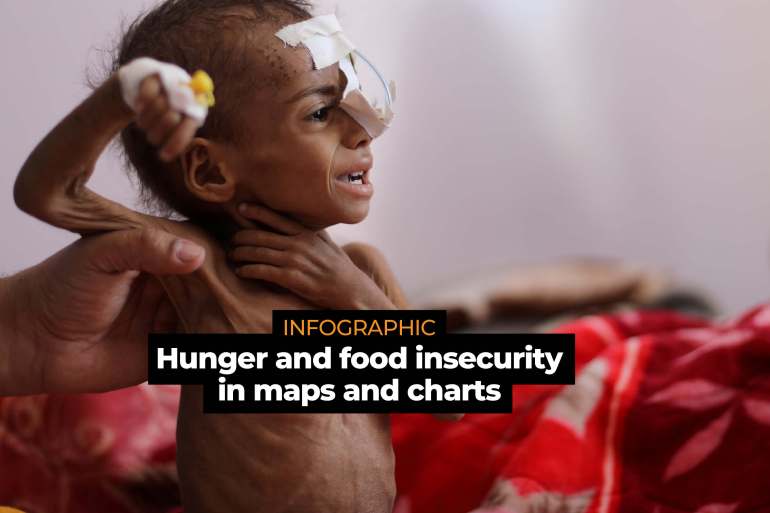Infographic: Hunger and food insecurity in maps and charts
As many as 811 million people – 10 percent of the world’s population – go to bed hungry each night.

Hunger levels are rising around the world.
As many as 811 million people – or 10 percent – of the world’s population go to bed hungry each night, 161 million more than the previous year.
In 2021, hunger and famine-like conditions were driven up by a combination of factors including conflict, the impact of COVID-19, extreme weather, plant pests, and difficulties reaching people in need, according to the 2022 UN Global Humanitarian review (pdf).
How are food insecurity and hunger measured?
According to the UN Food and Agriculture Organization (FAO): “Hunger is an uncomfortable or painful physical sensation caused by insufficient consumption of dietary energy”.
To measure global hunger rates, the UN combines country data on food availability, food consumption, and energy needs into a “prevalence of undernourishment” (PoU) indicator.
Based on this, the UN estimates the number of hungry people in the world to be between 720 and 811 million.
Food insecurity is when a person lacks “access to enough safe and nutritious food for normal growth and development and an active and healthy life” due either to the unavailability of food and/or lack of resources to obtain food.
FAO measures it using the Food Insecurity Experience Scale (FIES) shown below:

Below are maps highlighting some of the countries in most need of food.
Afghanistan
Afghanistan is among the highest levels of food insecurity around the world. At least 37.7 million of its population of 40 million people – 93 percent – do not have enough food.
A record 23 million Afghans face acute hunger, with nearly 9 million a step away from famine, according to the World Food Programme (WFP).
Two in five children (38 percent) under the age of five face chronic malnutrition – that is inadequate nutrition over a long period of time – which has led to stunted growth. Up to 1 million children under five are at risk of dying from malnutrition.
Since the August 15 Taliban takeover of Kabul, an already war-devastated economy once sustained by international donations alone is now on the verge of collapse.
In January, the UN asked donors for $4.4bn in humanitarian aid for 2022, the largest appeal ever sought for a single country. The UN Development Programme has warned that 97 percent of the population could fall below the poverty line by mid-2022.

Yemen
Yemen is one of the world’s poorest countries. According to the latest figures from the WFP, nearly half of the country (14.3 million) of 30 million people do not have enough food.
Nearly half (47.5 percent) of the country’s children under the age of 5 face chronic malnutrition.
A seven-year war has left at least 4 million people displaced and thousands dead.
The WFP said that it needs $802.4m from December 2021 to May 2022 to continue providing food and nutrition assistance and logistics.
$1.7bn are still needed for food security and agriculture, and $10m for logistics.

Syria
After more than 10 years of conflict, Syrians are facing unprecedented levels of poverty and food insecurity. Some 12.4 million Syrians, out of a population of 20 million, do not know where their next meal will come from, an increase of 4.5 million in the last year alone and the highest number ever recorded.
Nearly one in three children (27.9 percent) under the age of 5 are living with chronic malnutrition.
Over the past few weeks, bitter winter conditions have compounded the poverty of millions of displaced people in northwest Syria where the cost of living has skyrocketed over the past year.
Over the next six months, the WFP says it needs $365.8m in funding to support households in need.

South Sudan
South Sudan is suffering its highest levels of food insecurity and malnutrition since independence in 2011.
According to the WFP, more than half the population (6.6 million out of 11 million) have insufficient food. One in three children under five suffers chronic malnutrition.
The continued conflict and the worst flooding in decades have wreaked havoc on vulnerable communities.

The Democratic Republic of the Congo
The West African nation has the largest number of highly food insecure people in the world: some 43.3 million out of the population of 106 million.
According to Integrated Food Security Phase Classification (IPC), 27 million people in the DRC are highly food insecure, with 857,000 children and 468,000 women likely suffering from acute malnutrition.

Somalia
Deteriorating security conditions and a crippling dry season has left upwards of 90 percent (11.4 million) of the East African country’s 12.3 million people hungry.
According to Famine Early Warning Systems, people have experienced not only a decrease in food supply and income, but also a prolonged drought, flooding in early 2020, a desert locust surge, the economic impact of COVID-19, and security issues with armed groups. These have made the dire situation extremely complex.



No comments:
Post a Comment
Note: only a member of this blog may post a comment.